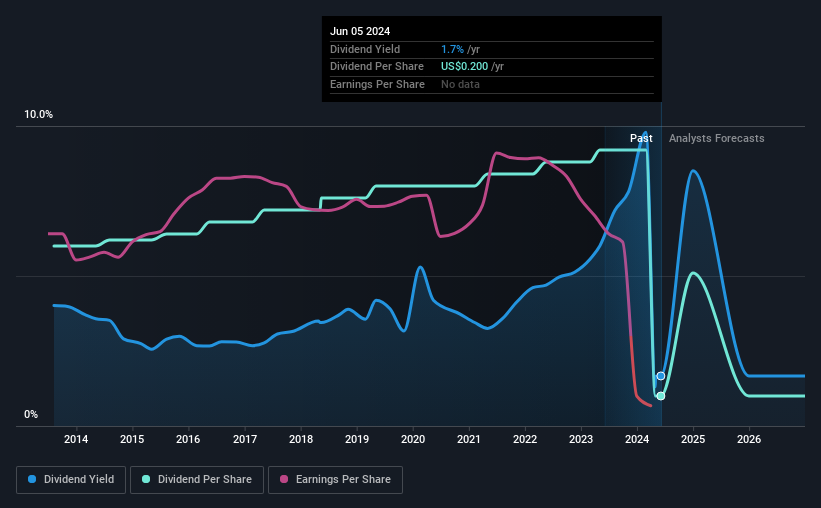Leggett & Platt's (NYSE:LEG) Dividend Will Be Reduced To $0.05
Leggett & Platt, Incorporated's (NYSE:LEG) dividend is being reduced from last year's payment covering the same period to $0.05 on the 15th of July. Despite the cut, the dividend yield of 1.7% will still be comparable to other companies in the industry.
While the dividend yield is important for income investors, it is also important to consider any large share price moves, as this will generally outweigh any gains from distributions. Leggett & Platt's stock price has reduced by 42% in the last 3 months, which is not ideal for investors and can explain a sharp increase in the dividend yield.
See our latest analysis for Leggett & Platt
Leggett & Platt Doesn't Earn Enough To Cover Its Payments
While it is always good to see a solid dividend yield, we should also consider whether the payment is feasible. While Leggett & Platt is not profitable, it is paying out less than 75% of its free cash flow, which means that there is plenty left over for reinvestment into the business. In general, cash flows are more important than the more traditional measures of profit so we feel pretty comfortable with the dividend at this level.
The next 12 months is set to see EPS grow by 152.7%. If the dividend continues on its recent course, the company could be paying out several times what it earns in the next 12 months, which could start applying pressure to the balance sheet.
Dividend Volatility
While the company has been paying a dividend for a long time, it has cut the dividend at least once in the last 10 years. The annual payment during the last 10 years was $1.20 in 2014, and the most recent fiscal year payment was $0.20. This works out to a decline of approximately 83% over that time. Declining dividends isn't generally what we look for as they can indicate that the company is running into some challenges.
Dividend Growth Potential Is Shaky
Given that dividend payments have been shrinking like a glacier in a warming world, we need to check if there are some bright spots on the horizon. Leggett & Platt's earnings per share has shrunk at 15% a year over the past five years. Such rapid declines definitely have the potential to constrain dividend payments if the trend continues into the future. On the bright side, earnings are predicted to gain some ground over the next year, but until this turns into a pattern we wouldn't be feeling too comfortable.
Leggett & Platt's Dividend Doesn't Look Sustainable
In summary, dividends being cut isn't ideal, however it can bring the payment into a more sustainable range. The company is generating plenty of cash, which could maintain the dividend for a while, but the track record hasn't been great. We would be a touch cautious of relying on this stock primarily for the dividend income.
Investors generally tend to favour companies with a consistent, stable dividend policy as opposed to those operating an irregular one. Meanwhile, despite the importance of dividend payments, they are not the only factors our readers should know when assessing a company. To that end, Leggett & Platt has 2 warning signs (and 1 which is concerning) we think you should know about. If you are a dividend investor, you might also want to look at our curated list of high yield dividend stocks.
Have feedback on this article? Concerned about the content? Get in touch with us directly. Alternatively, email editorial-team (at) simplywallst.com.
This article by Simply Wall St is general in nature. We provide commentary based on historical data and analyst forecasts only using an unbiased methodology and our articles are not intended to be financial advice. It does not constitute a recommendation to buy or sell any stock, and does not take account of your objectives, or your financial situation. We aim to bring you long-term focused analysis driven by fundamental data. Note that our analysis may not factor in the latest price-sensitive company announcements or qualitative material. Simply Wall St has no position in any stocks mentioned.

 Yahoo Finance
Yahoo Finance 
